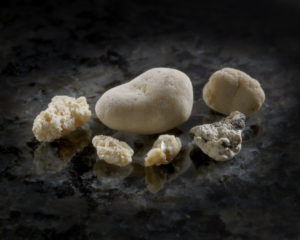Large kidney stones require more extensive treatment.
Large kidney stones are stones that measure approximately 5 mm or larger. Based on their size, they may have trouble moving through the urinary tract out of the body. In fact, they are prone to become lodged causing severe pain and other symptoms.
Large kidney stones require intervention for removal, typically, a surgical procedure. Reasons that initiate surgical treatment include:
- A stone that becomes lodged and won’t pass on its own.
- Severe pain that makes it difficult to wait for the stone to pass on its own.
- Having an infection.
- Having a stone that is blocking the flow of urine from the kidney.
How large kidney stones are treated
There are several methods for breaking down or removing large kidney stones, whether minimally invasive or surgically.
Lithotripsy
Extracorporeal shock wave lithotripsy (ESWL) is an outpatient procedure that requires either light sedation or anesthesia and usually lasts between 45 minutes and an hour. A lithotripsy uses shock waves that work to break up the kidney stone into much smaller pieces that will pass more easily through the urinary tract.
A ureteroscopy is generally an outpatient procedure that is performed under anesthesia. During this procedure, the surgeon will insert an ureteroscope through the urethra and bladder to the ureters. The ureteroscope is a thin, lighted, tube-like instrument with an eyepiece that allows the urologist to see the kidney stone. Once located, it can be retrieved or broken into smaller pieces using laser energy.
Sometimes, the surgeon will choose to place a stent in the ureter (the thin tubes that allows urine to flow from the kidneys to the bladder). If placed, it will be removed in approximately four to 10 days during an office visit.
Surgical removal
Depending on its size and location, the urologist may choose to perform a Percutaneous Nephrolithotomy (PCNL). This procedure requires general anesthesia, and may require an overnight stay in the hospital.
When performing a PCNL, the urologist uses a nephroscope, a thin, telescopic instrument that is inserted through a small incision in the patient’s back or side, to locate the kidney stone. Once it has been located, another instrument is used to break up and suction out the pieces of the kidney stone.
When the PCNL procedure is complete, the urologist will leave a nephrostomy tube in the kidney so that urine and leftover stone fragments can leave the body. The nephrostomy tube will be removed in a day or two following the procedure. Patients are generally permitted to return to normal activities within one to two weeks.
Contact Urology Austin to schedule an appointment at the location nearest you.

